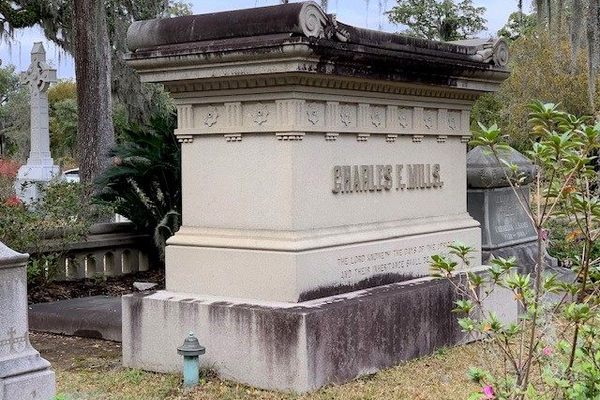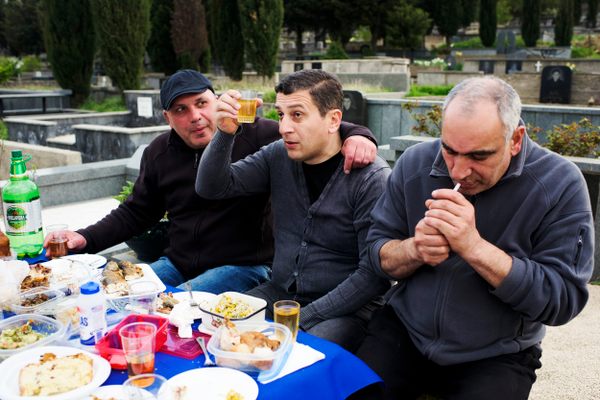We Have a Copy of Patricia Highsmith’s Unpublished Essay on Green-Wood Cemetery

At Green-Wood (Photo: katherine weil/Flickr)
Late in October of 1987, the psychological thriller author Patricia Highsmith took a car over the Manhattan Bridge and through Brooklyn to Green-Wood Cemetery, a sprawling, park-like expanse of crypts and tombstones. The New York Times had commissioned her to write a detailed account of the place, and it seemed like a natural assignment. When she was a teenager, Highsmith had written that “the morbid, the cruel, the abnormal fascinates me,” and that proclivity had come out in her novels, in which tense plots followed strange people, most famously The Talented Mr. Ripley, through obsessions that usually led to murder.
The essay that Highsmith wrote about Green-Wood was never published. The only way to read it, right now, is to travel to the Swiss Literary Archives, in Bern, where Highsmith’s papers went after her death, or—as Atlas Obscura did—request a copy of the unpublished manuscript.
In the account, Highsmith, who had a reputation for being an unpleasant person who preferred snails to humans, is a sharp but empathetic observer of Green-Wood’s “dead and buried.” These were people, she observes, who “want to be remembered, not only by family…but by the public.”
It’s an essay with haunting moments—most of all when Highsmith sticks her hand into the warm furnace where dead bodies are burned to ashes. While she’s in the cemetery, the aging writer, fixated her whole career on subjects most would find creepy, considers the lingering results of fame, accomplishment, and death. It also happened that she wrote the essay not long after she had directly faced the possibility of her own death, twice.

Patricia Highsmith, appearing on After Dark in 1988 (Photo: Open Media Ltd./Wikimedia)
The year before Highsmith got the assignment, a doctor had found a malignant tumor on her lung, which, she wrote, “sounds like a death sentence to me, taken out or not.” She was only 65. Not long before that, she had spent nearly a week in the hospital, after a hemorrhage caused her to lose so much blood that the lifelong heavy drinker feared she might die alone, behind a closed door.
There was no particularly strong reason to send Highsmith to Green-Wood in 1987. The year before, the Museum of the Borough of Brooklyn had put on an exhibit featuring the art of people buried there. But in late 1987, Highsmith, who had lived abroad in Europe for years, had a new novel coming out, this one set in New York City.
She was a famous enough novelist that magazine editors wanted her non-fiction, too, and though she had written about less gothic subjects—her cats, her first job, Greta Garbo—many of her essays had covered the same macabre ground, of murderers like Jack the Ripper, Jeffrey Dahmer, and children who kill, that her novels did.
Perhaps the author and the subject just seemed to fit together. “Because of her status of the “Mistress of Suspense” (to borrow the name of a British TV series made from some of her short stories) she was often commissioned to write about death and murder,” says Andrew Wilson, the author of Beautiful Shadow, a biography of Highsmith.

At Green-Wood (Photo: Mike Steele/Flickr)
Green-Wood is a rambling place, designed in the 1830s, when garden cemeteries had become both a practical and pleasant solution to the problem of urban burial. These tree-filled cemeteries were some of America’s first city parks, and in the 1850s, when Central Park was still under construction, Green-Wood was one of the most popular tourist attractions not just in New York City, but in the entire country. Through the 19th and 20th centuries, many of New York’s luminaries were buried there, some beneath elaborate monuments to their accomplishments.
“The interesting thing about Green-Wood Cemetery is that it was an immediate ‘success,’” Highsmith wrote in her essay. “Surely the Victorians had of necessity a very realistic attitude toward death…Death was King in a sense, and if you can’t lick him, why not join him? Even throw a party?”
The subtitle of Highsmith’s essay was “Listening to the Talking Dead,” and from the beginning, she is in an empathetic state of mind. On the way to the cemetery, she imagines a family of mourners making the same journey; she notices a truck of trash that’s headed to its own burial ground, “some cemetery or incinerator for garbage,” she wrote. “Its apparently inexhaustible drip of squashed vegetable matter or leftover orange juice reminds me of human mortality, with its attendant ugliness, stench and inevitability.”
Highsmith was accompanied by a Times researcher—Phyllis Nagy, who would go on to become a screenwriter and whose film adaptation of Highsmith’s second novel, Carol, will be released later this year—but as they drive together through the cemetery with an enthusiastic young guide, Highsmith’s focus is on the monuments they pass. She notes that an “eye-catching tomb shows a female figure in stone, life-sized, collapsed on the stone steps which lead to a block of rough marble surmounted by a rugged cross” and that “angels of all sizes weep gracefully everywhere.”
There’s no real structure to the essay; in the draft, Highsmith simply recreated the journey she had taken through the grounds. The most dramatic moments comes about three-quarters of the way through, when Highsmith goes to the crematorium. She’s a little bit shy, here: “I would like to see the interior of the building, first of all, and I don’t know how far I dare ask to see,” she wrote, but she’s guided to down to the row of five industrial furnaces. She puts her hand inside one of them.
“The warmth of that retort, even though it may have come from a pilot flame, brought home death to me as none of the stone monuments above ground had,” she wrote. “There I go in a few years, I thought, as cremation is my preferred way, ashes to be scattered any old where that is permitted. So my head is a bit light as we walk on via a near-by hall to the elegant Columbarium…”
After that brush against the thought of mortality, she visits the walls of urns, considers the price of various burial options, and walks past a few more grave sites. Her overall impression, she wrote, was “a cheerful one.”
“Go out in style, and with as much dignity and grace as possible,” she wrote. As she passes back through the cemetery gates, she considers that “the dead can still live in the memory of those who loved them, or of those who may learn to respect them. That was the last message to me conveyed by Green-Wood.”

The gates of Green-Wood (Photo: katherine weil/Flickr)
The piece never ran. “I do think the editors simply did not care for the piece,” Nagy wrote in an email.
Highsmith lived another seven and half years after that trip to Green-Wood. Although by the end of her life, she was famous in Europe, where she had lived since the early 1960s, in America, she was still something of a cult classic. Her first book, Strangers on a Train, had become a Hitchcock film; European directors had adapted Ripley for the screen, and in 1988, the New Yorker had reviewed her work favorably, calling her books “the queasiest fun imaginable” and “fiction too abandoned to care what it’s called, literature or trash, that celebrates restlessness and volatility.” But when Highsmith died, she didn’t even have an American publisher.
“Towards the end of her life she became increasingly misanthropic—one person I interviewed told me she was ‘an equal opportunities offender’—she offended everyone!” says Wilson. “But those who knew her loved her, despite or because of her quirks and flaws. During the course of my research, I became quite fond of her too, of her black humor, her grumpiness, her unsentimental perception of the world, and her honesty.”
It’s funny how memory works. When Nagy recalled her first ride with Highsmith, she described it to Wilson as “a completely silent, miserable journey to the cemetery except for the three occasions when Pat spoke to me.” But in the essay, the perspective is turned, and Highsmith describes Nagy (although not by name) as “my rather taciturn companion from the Times.” The two later came to be close friends.
In all accounts, though, Highsmith comes across as a sometimes difficult person to be around, but an easy one to respect. “It was a brave step for her to undertake the commission to write about Green-Wood,” Wilson says. In her private notebooks, the author had written of her intention not to fear dying alone, that she’d “always known death was an individual act, anyway.” But, as Wilson recounts in his book, the cancer in her lung frightened her. When Highsmith first heard the news, she took out a flask of whiskey, right in the doctor’s office, to take a drink, and later told friends that the operation had scared her. She quit smoking, a lifelong habit. When the results came, eventually, that the cancer had not regrown, she wrote that “it is like a reprieve from death.”
This is the context in which she visited Green-Wood and stuck her hand into crematory furnace. “The ovens were still warm,” Nagy told Wilson, “and you could hear the bones being grated in this huge blender. It was pretty gruesome.”


















Follow us on Twitter to get the latest on the world's hidden wonders.
Like us on Facebook to get the latest on the world's hidden wonders.
Follow us on Twitter Like us on Facebook